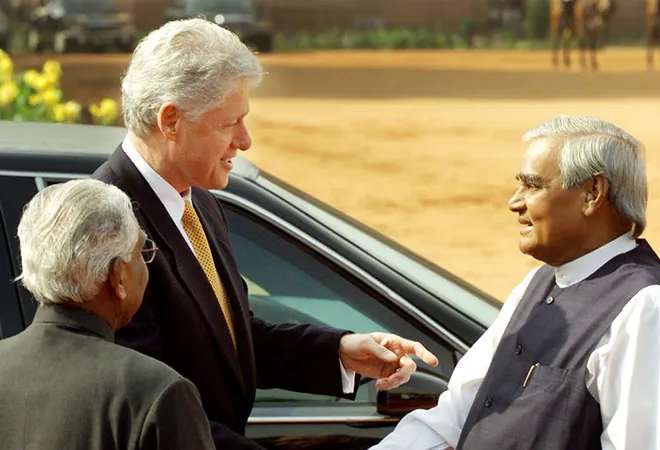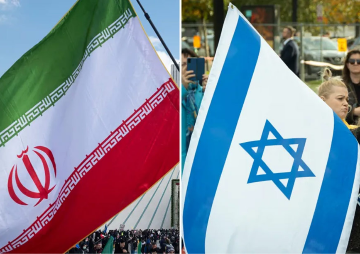
On 7 May 1960, Jawaharlal Nehru laid the foundation of an organization that would play a major role in future Indian strategic policy- the
Border Roads Organisation (B.R.O.), having primary role of providing defense infrastructure including roads, bridges, highways, airports, tunnels, buildings and other such structures. Geographically located at a critical juncture, facing survival threats of war, insurgency, smuggling, it was very important for India to develop an organization that would form the skeleton of Indian strategic policy. Border Infrastructure and strategic policy go hand in hand. As infrastructure develops, so does the boldness in strategy policy. In the 21
st century, a strong border infrastructure also needs technologically advanced surveillance. As new challenges develop like infiltrations, muscle flexing, illegal immigration and smuggling, border infrastructure also develops, strengthening the strategic policy.
India’s primary threat is a two front war due to unconventional warfare by Pakistan and muscle flexing by China. Thus, in the Northern part of India, there are military and para-military establishments at a stone’s throw away from each other. But without a strong border infrastructure, it all falls flat. For example, during the Kargil War,
Srinagar-Leh highway was targeted by Pakistani troops as this is the most important route connecting the two regions which then further connects Siachen. There is another through the Rohtang Pass but remains closed half the year due to snow. Therefore, it is of utmost necessity to open a third route.
Apart from quick troop movements, curbing of illegal activities like smuggling, illegal immigrations, counterfeit currency also needs to be done at the border and proper infrastructure needs to be made for it. Such activities are responsible for the drug problem of Punjab and illegal immigration problem of Assam. In order to counter such myriad of problems, the
Border Roads Organisation (B.R.O.) and
C.I.B.M.S. (Comprehensive Integrated Border Management System) has been working to provide state of the art infrastructure.
B.R.O. has constructed lifelines of over 53,600 km for the people of Sikkim , Arunachal Pradesh, Mizoram, Manipur, Nagaland, Tripura, Meghalaya, Ladakh, Jammu & Kashmir, Uttarakhand , Himachal Pradesh and Andaman & Nicobar Islands. One of the most important ones has been Project Sampark, carved out of Project Beacon, on 1
st January 1975, covering south of Pir Panjal, parts of Himachal Pradesh and Punjab. Project Sampark has achieved 1200.72 m bridge targets in 2019-20 which is almost 40% of the entire B.R.O. achievements.
Technological border surveillance has been done through C.I.B.M.S. (Comprehensive Integrated Border Management System). Sensors like thermal imagery, unattended ground sensors, fiber optical sensors, radar are used in C.I.B.M.S. It had been implemented on a pilot basis in a stretch of Jammu. Here, CIBMS nabbed several intruders with
large consignments of heroine and fake currency. Some of the C.I.B.M.S. components had shown results in an individual basis like
thermal imagery foiled an infiltration attempt by Pakistan’s SSG.
Rising threat across the border has accelerated B.R.O.’s activities. Recently, under Project Sampark,
6 new bridges in Jammu and Kashmir were inaugurated by the Defence Minister, Rajnath Singh, helping in smooth movement of Indian Forces in the strategically important region of Kashmir, around the International Border and the L.O.C. Since 2017-18, the B.R.O.’s activities have witnessed a surge of 44% in formation cutting, 55% in permanent works, 17 % in major bridges, 15 % in surfacing and 49 % in resurfacing works. The strategic policy of India has, as a result, has become more aggressive. The
Surgical Strike in 2016,
Balakot Airstrike in 2019, followed by continuous pressure on FATF in grey listing Pakistan and building the perception of Pakistan as a terror state is an unparallel victory of Indian Forces and diplomacy. Other than factors like force modernization, a strong border infrastructure at the helm is a very important factor for this achievement, as it gives the confidence that military can mobilize the border in a matter of hours and in some cases, minutes.
Similarly,
Atal tunnel, the world’s longest highway tunnel (9.2 kms) connecting Manali to Lahaul-Spiti cuts time by 4-5 hours and will be open throughout the year. Earlier, this route was closed for 6 months due to snowfall. It will help faster troop movement towards the China border, including armored vehicles and artillery. After this success, an underground tunnel at Shinku-La for an
all-weather road to Ladakh via Darcha-Padam-Nimu route will be completed in three years. In addition, with lessons from Kargil, on 27 July, 2020 the B.R.O. teams in the Zanskar region achieved physical connectivity of the
Nimmu-Padam-Darcha (NPD) road section. This two-lane road will be completed by 2023 - the third link of Srinagar to Leh, increasing India’s capability to face a two-front challenge.
On the same lines, the
Sela Pass tunnel will be constructed in Arunachal Pradesh, another theatre of India-China conflict. Along with
Daporijo Bridge over Subansiri river, connecting Assam to Arunachal, B.R.O. has completed
44 of the 102 bridges under construction for this year. These are class 70 bridges, able to bear the weight of 70-ton vehicles making Arjun (60 ton) and T-90 Bhishma (45 ton) tanks possible to cross over these bridges. These projects will embolden diplomatic and military moves by India in the North-East as well.
Along with physical infrastructure of B.R.O., C.I.B.M.S. is electronically surveying some parts of the border. One part of C.I.B.M.S. recently inducted on a pilot basis is
BOLD-QIT (Border Electronically Dominated QRT Interception Technique) at the Pakistan (10 kms) and Bangladesh (61 kms) borders.
This system will monitor unfenced riverine areas of Brahmaputra and its tributaries, thus reducing problems of illegal migration and smuggling from Bangladesh. Entire Brahmaputra has been covered with data network generated by Microwave communication, OFC cables, DMR communication, day and night surveillance cameras and intrusion detection system, giving feed to BSF control room who send Quick Reaction Teams to thwart any illegal activity. However, C.I.B.M.S. has some problems. There are technical and maintenance issues such as lack of experts on ground to handle the tech savvy C.I.B.M.S. creating lack of speed due to which the illegal cross border activities are not witnessing any respite. Acceleration is the need of the hour.
In addition, administration needs to give more importance to porous borders of Nepal, Bhutan and Myanmar. The porousness of these borders make it a hot bed of illegal activities like
gold smuggling through Bhutan border,
artefact smuggling in Nepal border and
drugs through the Myanmar border along with insurgency. Being so close to
the Golden Triangle should spur our agencies into action, bringing strong infrastructure development, followed by the usual strategic policy to completely eliminate the problem.
The following tables provide a gist of border infrastructure development:
|
Pakistan |
China |
Bangladesh |
| Main Threat |
War, insurgency, smuggling. |
War |
Smuggling, human trafficking |
|
What needs to be done?
|
C.I.B.M.S. monitoring with a well-trained and larger BOLD-QIT, more than one route connecting far flung areas, especially Jammu and Kashmir |
Armored vehicle capable infrastructure, high altitude airfields. |
C.I.B.M.S. monitoring with BOLD-QIT throughout including riverine stretches |
| What has been done? |
C.I.B.M.S. in some stretches, 3rd route to Leh to be opened by 2023. |
Daulet Beg Oldie airfield running, some bridges and tunnels armored vehicle capable. |
Brahmaputra river covered, rivulets still remaining. |
|
Nepal |
Bhutan |
Myanmar |
| Main Threat |
Smuggling, human trafficking |
Smuggling |
Smuggling, insurgency, trafficking. |
| What needs to be done? |
C.I.B.M.S. monitoring with BOLD-QIT |
Armored vehicle capable road connectivity till Bhutan-China border. |
C.I.B.M.S. monitoring with bigger and more efficient BOLD-QIT to tackle insurgency, roads for swift troop movements |
| What has been done? |
Planning stage. |
B.R.O. working on it. |
Some roads present. C.I.B.M.S. planning stage. |
Major powers are well aware of the importance of a strong connectivity. China has been linking Xinjiang to Tibet through Aksai Chin and also protesting when India works on the
Daulet Beg Oldie-Shyok-Darbuk road. One of the reasons for the
Galwan Valley clash was fast Indian progress on this road. This road will enable faster movement of troops and armored vehicles greatly irking China. Similarly, China is building the Karakoram Highway to secure its energy interests to completely avoid the South China Sea route.
In 2018, the Indian
government approved Rs. 8,606 crore for Border Infrastructure development and Management (B.I.M.) to be developed in 17 states having international borders. It consists of 60 projects including construction of roads, schools, primary health centres and so on. Although this will improve border management, the problems faced by porous borders will still remain. The out of the box thinking and will power with which the B.R.O. and C.I.B.M.S. is working in tandem with policy planners on the Pakistan and China borders needs to be mirrored in the porous borders as well.
The views expressed above belong to the author(s). ORF research and analyses now available on Telegram! Click here to access our curated content — blogs, longforms and interviews.



 On 7 May 1960, Jawaharlal Nehru laid the foundation of an organization that would play a major role in future Indian strategic policy- the
On 7 May 1960, Jawaharlal Nehru laid the foundation of an organization that would play a major role in future Indian strategic policy- the  PREV
PREV

